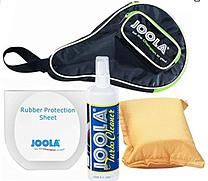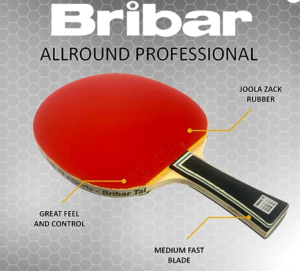
Within table tennis there is a main game style that most people adhere to. However, occasionally you will come across a player with a very different style than you are used to. This strange style is often accompanied with different type of rubber. So the question is: what is the difference between types of rubber in table tennis? In this post I aim to make clear the main differences between all the rubbers, what their advantages and disadvantages are and how to recognise these types of rubber.
Inverted Pimples
We will start with the most common type of rubber – inverted pimples. Because they are the most common their are other names that people may refer to them as such as: pimple-in rubbers or smooth rubbers. They are called this as they have very small pimples of rubber that face in towards the sponge that leave a smooth sheet of rubber facing out.
While this surface is smooth, it usually has lots of friction. This allows the bat to “grip” the ball and generate spin which is the key difference compared to the other types of rubber. Generating spin is a large part of table tennis and these inverted pimple rubbers are the best type of rubber for doing just that.
Since these rubbers are the most commonly used, there are a lot more versions on the market. All slightly different with a focus on different attributes. The main three attributes being: speed, spin and control. Once you have chosen your rubber you can also choose the size of sponge that comes with it which adds another level of customisation to your bat.
From this you can see some clear advantages of this type of rubber. You can generate incredible amounts of spin and you can keep refining your customisable build until it perfectly suits your play style.
Due to the rubbers grip on the ball, an already spinning ball will react a lot off of an inverted pimples rubber. This can make it difficult to control other peoples spin. Also, since most players exclusively use inverted pimple rubbers you shots, serves and play style will be more than likely “normal” to all the players you play against.
Short Pimples
Short pimple rubbers have small, conical-shaped pips that are closer to the base surface. This results in a flatter and less grippy surface compared to inverted rubbers. The pimples are usually stiffer and less flexible. Short pimple rubbers tend to produce faster shots compared to inverted rubbers due to the contact time with the ball being much shorter.
These short pimples have much lower friction when compared to the inverted pimples. This has two main effects: they can not generate spin anywhere close to the level that inverted pimples can and a spinning ball reacts less on the short pimples. This allows players to use the short pimple rubber to “hit through” spin in a way that the inverted rubber just can’t. Due to this, these rubbers excel in blocking and counterattacking against opponents’ spins. Short pimples suit players who want to stay close to the table and take control of the rally.
The advantages of using short pimples are being able to reduce the effectiveness of opponents spin and have faster shots. On the other hand, short pimples struggle to generate lots of spin even though they can generate some with practice.
Long Pimples
Long pimple rubbers are a specialised type of table tennis rubber with longer and more flexible pips on the playing surface. These rubbers provide a distinct playing experience compared to regular inverted or short pimple rubbers. Long pimple rubbers are often chosen by players who prefer a defensive play style.
Long pimples have even lower friction than the short pimples, this means it is very difficult to generate any of your own spin. However, because there is very little grip on the ball, when a spinning ball makes contact with the long pimples the ball continues spinning as there is very little resistance. This means that the ball will be sent back to your opponent with the same spin that they sent to you. Although, from their perspective it will seem as though the spin has reversed. This concept is looked at further within the long pimple specific post.
Long pimples often cause the ball to “wobble” through the air due to this spin affect. This leads to a main advantage of the long pimples – being able to confuse opponents with strange spins. Long pimples can contact the ball in two ways: hitting the pimples or bending the pimples. Hitting the pimples will still cause some reversal but will also remove some spin sending a floatier ball back. Bending the pimples will create more spin reversal and also add to the spin. Long pimples are also often used to slow down the ball, this change of pace can be really off-putting to attacking players.
While the long pimple rubber is extremely good for defense and confusion, they are very difficult to attack with. So, if you are looking to be an attacking player, you will probably want to avoid long pimple rubbers. Also, the main advantage of long pimple rubbers is to reverse your opponents spin. If your opponent doesn’t generate any spin then the long pimples have nothing to reverse and since they struggle to generate their own spin it can cause problems for your game.
Antispin
Antispin rubbers look very similar to the inverted pimple rubber. However, the antispin rubber has almost no friction. This rubber has the least amount of grip compared to any other type of rubber. They are designed to minimise the effects of the opponents spin making it much easier to deal with heavy spin.
Antispin is very similar to long pimples in its play style and what its advantages and disadvantages are. However, antispin is slightly better for removing spin compared to the long pimples and slightly harder to attack with. Antispin definitely suits a defensive game style. If you are thinking of using long pimples or already use them it may be worth trying antispin as that may end up suiting your game slightly better – it all depends on what specifically works for you.
Conclusion
Within table tennis there are many options to try, no single option is the correct answer. Different rubbers will suit different play styles and different people. If you are unsure of what rubbers to use I will always advise starting with inverted pimples first as it is the most standardised way to play and only when you have the basics down should you venture out and explore different options. The discussion around types of rubbers is a complicated one and also something that a lot of players don’t try to understand which can impede their progress. With that being said if you have any questions around the types of rubber feel free to leave a comment under this post and I will try to answer it to the best of my ability.



Getting started with the inverted pimples as a beginner was fun. Although, I did not know the difference between all of the rubbers. What excited me most was the spin it generated. I always wondered why it differs from other rubbers. Thank you for this detailed explanation. I now see the spin as a result of friction from the smooth surface.
I’m glad you found this post helpful! The spin that can be generated by the inverted pimples is what draws most players to them however, don’t let this stop you from exploring other avenues. It could be just what your game needs!
Many thanks,
Bailey
I was very pleased to find this article about the different types of rubber in table tennis paddles, as it reminded me of my spare time in college when I used to play ping pong. As with most of us who played there, my preference was for paddles with inverted pimples. Very few players used other types of rubber, and I never quite understood the difference, or the advantages and disadvantages. Now it’s clear to me after reading this great article.
By the way, the paddles that had a different type of rubber on each side of the paddle caught my attention. I never understood what their advantages could be, nor how to get used to using them. How common is it to use paddles with different types of rubber on each side at a competitive level?
Thank you for sharing your experience and advice on this interesting topic.
Hi Pablo, as you have noticed the inverted pimples are the most common way to play and that is because their spin generation is almost a necessity within table tennis. Because of this, if you want to use a pimples-out rubber, you will still to be able to generate spin somehow. This means that most players have one inverted pimple rubber and then a pimples-out rubber to complement their play style as well. Occasionally, at local league level you may find a player that uses two pimples-out rubbers and rarely you will find them playing at a higher level than that.
At the professional level, it is dominated by players that use exclusively inverted pimple rubbers however, there are a few players that can compete with the very best using a pimples-out rubber. To my knowledge though, all of these players also have one inverted pimple rubber as well. The top level of the women’s game tends to include more pimples-rubbers than the mens. So, if you are interested in how pimples-out rubbers are used at the top level it may be better for you to pay attention to the women’s matches as you are more likely to see them in action.
if you have any other questions please let me know!
Many thanks,
Bailey
Hey, your breakdown of the differences between various types of rubber in table tennis is quite insightful. It’s essential information for players looking to optimize their equipment. I’m curious, though, how do these rubber characteristics translate into performance differences on the table? Are there specific playing styles or techniques that benefit more from one type of rubber over another? Understanding this could help players make more informed decisions when choosing their table tennis equipment.
If you are an attacking player that doesn’t use much spin on your attacks then you should consider short pimples. If you are an attacking player that likes to use lots of spin the stick with the inverted pimple rubbers. If you like to defend then explore long pimples or antispin rubbers.
I would always recommend that you keep at least one of your rubbers as an inverted pimple rubber and then you can play around with something else on the other side of your bat. This is so that you will always have an option to generate heavy spin if it is needed.